Each and every step that a potential buyer takes on their path to purchase can bring them closer to or further from your brand.
Content marketing is how you earn those leads’ trust, and guide their decision-making processes in order to convert them into paying customers.
To succeed in this endeavor, you’ll need a solid sales and marketing strategy.
What is a sales and marketing strategy?
A sales and marketing strategy is an end-to-end game plan for how your business targets, reaches, engages, influences and converts leads with the intent of selling a product or service and subsequently maintaining loyalty.
Some might also call this a go-to-market strategy. But generally speaking, a GTM strategy also factors in pricing models, supply chain and other higher-level elements of the business structure as a whole.
In this sense, the sales and marketing strategy is nested within a GTM strategy.
Why you need a sales and marketing strategy
Simply put, people need a reason for why they should give you their money in exchange for a product or service. Happenstance referrals and word of mouth are convenient, but so is winning the lottery.
Just as your most pragmatic path to wealth is to consciously work toward it, the most direct route to customer acquisition is a deliberate and premeditated series of actions that helps funnel them to you on a consistent basis.
That requires a system that consistently generates leads, nurtures those leads into prospects and sells to those prospects.
Enter inbound marketing
Technically, an inbound marketing strategy (or pull marketing) is just one example of a type of sales and marketing strategy – but it’s also the best. The antithesis is outbound marketing, or push marketing.

Inbound-marketing leads close, on average, 14.6% of the time. By comparison, only about 1.6% of outbound leads (those generated from cold calls, advertising, direct mail, etc.) culminate in a purchase.
The simple explanation for this is that, with inbound marketing, you use content to automate the flow of leads and prospects into the bottom of the sales funnel. By the time they get on the phone with a sales rep, there’s plenty of context for the conversation.
This isn’t to suggest outbound marketing is a dying practice. Push and pull marketing both have their strengths and weaknesses, and you need professionals with outbound marketing experience on your team who have the moxy to move things deeper in the sales cycle (more on this in a bit).
But the most cost-effective marketing tactics are predominantly inbound. In fact, the total average cost per lead for inbound marketing is 61% less than the cost for outbound marketing ($135 vs. $346).
TL;DR: If you want a steady stream of leads and prospects, you’ll need to facilitate it with an inbound marketing campaign as part of your bigger sales and marketing strategies.
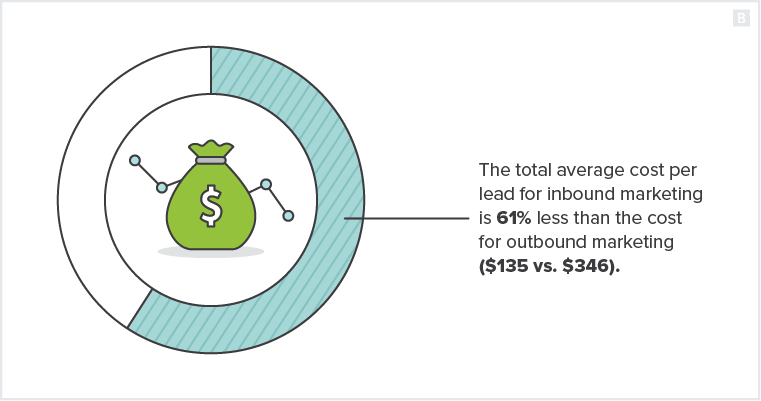
Marketing and sales alignment
Alignment between marketing and sales is implicit in any sales and marketing strategy – but especially in inbound marketing.
This is primarily due to the nature of the sales funnel. The point of a sales and marketing strategy is to slowly move high-quality leads closer to purchase intent through a series of short-term goals. Marketers prime the pump, so to speak, and it’s sales’ responsibility to strike while the iron is hot.
In other words, sales needs to be coordinated enough with marketing to know when it’s time to close.
The opposite is also true, though.
Marketers need to solicit information about leads from sales. Sales teams spend the most time interfacing directly with prospects – whether through emails, phone calls, in-person meetings or product demos. Consequently, they get first-hand insights into these prospects’ pain points and struggles.
Sales also has a strong idea of what value propositions prospects favor. They can pinpoint a subtle competitive advantage that marketers might overlook. Marketers can then use the insights to create content around those advantages. Content creators can also more effectively develop sales enablement content that has utility at the very end of the sales cycle.
The bottom line: Sales needs to coordinate with marketing so they know when to begin direct outreach based on prospect behavior (e.g., what content they’ve engaged with and the frequency in which they’ve engaged). Marketing, meanwhile, needs to be in alignment with sales so they can nail the messaging and better understand the target audience.
The all-important sales funnel
Every buyer journey is a little different, but most start with brand awareness and, if successful, lead to brand loyalty.
Phase one of this process is to create detailed personas that represent your target audiences. This is important for several reasons, the most obvious of which is that you need to know who you’re actually trying to sell to. That person, your buyer persona, may not always be the same as your most prolific readers.
For example, a few years ago, we learned through analysis of site traffic and conversions that our buyer persona was responsible for the fewest macro-conversions.
They weren’t the ones scheduling demos and sales calls with us.
Rather, influencers who don’t have buying power were bringing our brand to the attention of decision-makers.
This was important because it meant that our most important audience for our marketing campaigns wasn’t necessarily our buyer.
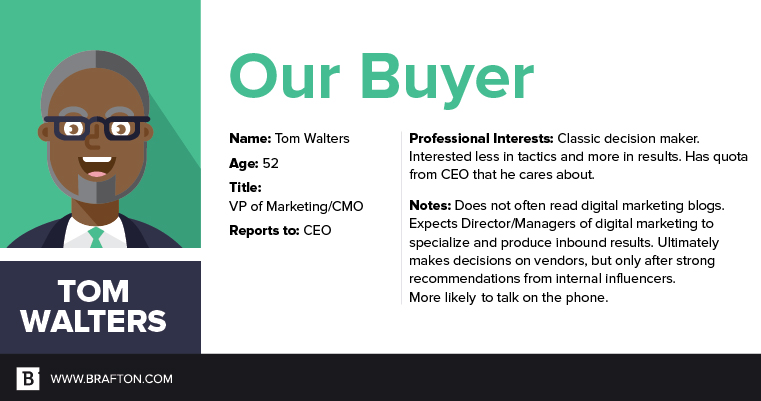
In this sense, we learned that our brand awareness efforts should be more targeted to our most avid readers. This led to the development of reader personas that we could base our marketing goals on.
Here are a few examples of those personas:
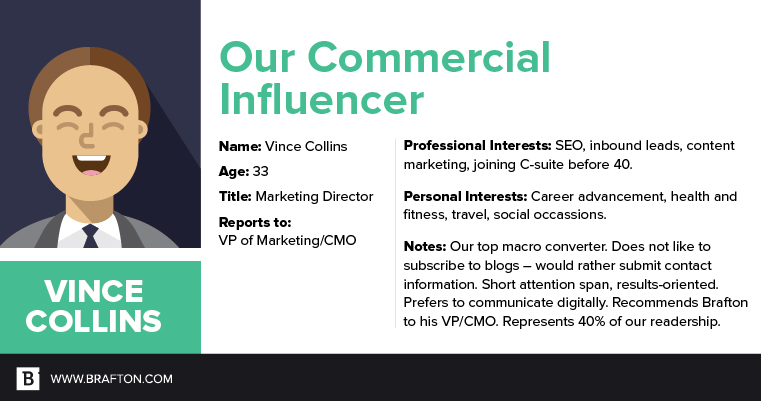
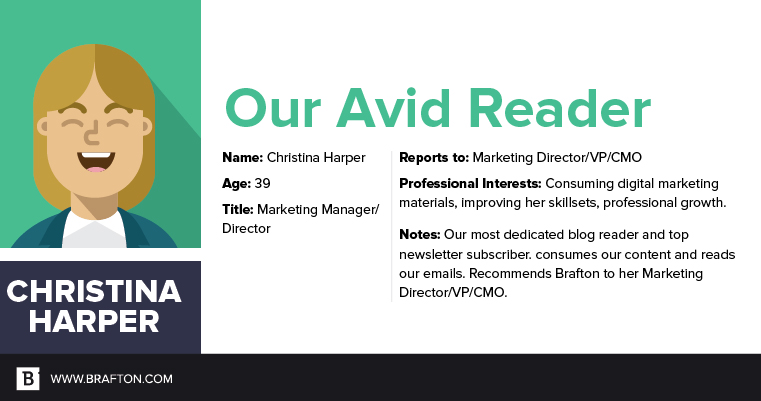
Once we know who we are targeting at the top of the funnel, we can begin to build brand awareness content around those audiences.
Building brand awareness content
Brand awareness content predominantly consists of blog posts, infographics and videos that act as informational resources for people like Christina Harper, but also social media marketing. The purpose of this content is to generate traffic and get your target audience’s attention.
Naturally, search engine optimization (SEO) plays an important role here.
You need to know what your influencers are searching for (and what keywords they’re using), and make sure that your content satisfies the intent of those queries. This ensures that your content has the dual function of making your brand more prominent on search engines while also building trust among your target audience.
As traffic filters into your funnel through your brand awareness content, leads will start to trust you and listen to you. They’ll be that much more likely to sign up for your newsletters, click through your email marketing campaigns and download your gated assets.
As that interest becomes more apparent based on how they interact with your brand, you can start to move into the consideration phase with case studies, testimonials and sales emails.

In the consideration phase with direct mail, marketers with outbound experience will be integral for drafting sales emails and demo requests.
At this point, your marketing goals shift to sales goals.
Leveraging sales enablement content
At the decision phase of the sales funnel, there are several opportunities to introduce sales enablement content.
Sales enablement content is exactly what it sounds like: It’s any content that sales teams can use as they attempt to close deals deep in the funnel.
This could be testimonials such as case studies that are shared with prospects. Alternatively, sales enablement content can be predominantly internal.
For instance, one of our clients creates case studies for as many of its customers as they can in order to demonstrate the value of its product to those customers. These case studies are posted on its website and are accessible to anyone.
However, in order to maximize the utility of those assets, they also create a single slide for each case study, summarizing the challenges, solutions, results etc. Each of those slides is added to a master SlideShare and indexed by industry and use case.
As sales associates meet with prospects, they can refer to this large catalog of case studies to quickly review real-world examples of how the product has already helped customers in that industry.
From here, they can direct the prospect to the full case study.
Alternatively, they might use those examples as talking points in a meeting, a demo or in a slidedeck as they sit down with the buyer.
The specifics of how they use that content is ultimately up to them, but the point is that they have a vast and handily indexed catalog of real examples that they can pull from as they speak with buyers.
B2C vs B2B sales and marketing plans
Some key differences exist between business-to-business (B2B) and business-to-consumer (B2C) marketing tactics.
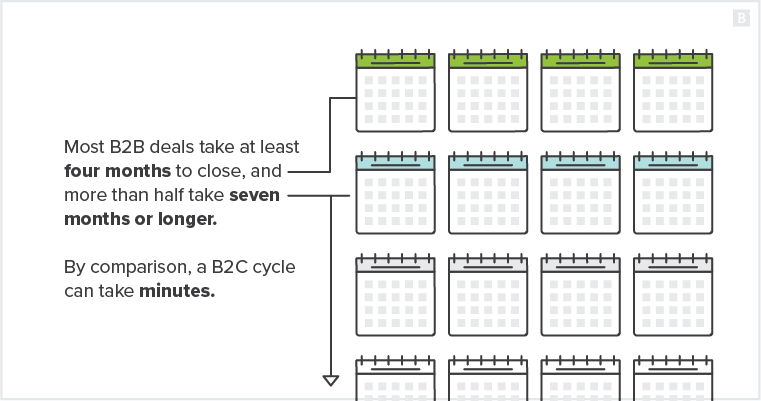
In B2B industries, the interest and consideration phases are typically much more drawn out than they would be in a B2C market. Most B2B deals take at least four months to close, and more than half take seven months or longer.
By comparison, a B2C cycle can take minutes.
This doesn’t make inbound marketing any less important. For instance, many of the same types of channels – social media, email, webinars, podcasts, web content, etc. – could be used in B2C e-commerce marketing strategies. Additionally:
- B2C brands still need to build credibility with their audience.
- They still need to make themselves visible on the web and on social media.
- They still need to do what they can do boost brand loyalty.
- They still have to spur on buying behavior with timely product recommendations and engagement efforts.
Achieving brand loyalty with ROI (B2B vs B2C)
Achieving brand loyalty is also a different game in B2C and B2B markets.
Companies in B2B markets are under greater pressure to demonstrate return on investment. Obviously, B2C products still need to add value, but that value is often more personal and qualitative.
Businesses always need to have a line drawn from a product or service to a commercial goal. This generally requires more in-depth data analysis, but the extra effort is worth it. Sixty percent of deals involving existing customers close in three months or less. In other words, it’s generally more cost-effective to build brand loyalty with existing customers than it is to attract brand-new customers.
Granted, there are plenty of examples where data is critical to keeping consumers invested in a product. A smart thermostat, for example, might track how much money on average it’s saving you.
But on the whole, B2B businesses are usually under much more pressure to quantitatively demonstrate value.
Setting up a referral program
Most B2B businesses also have referral programs that help expedite a lead’s transition into a prospect and, eventually, a customer.
Some of these programs may be based purely on word of mouth. Others are more formalized.
Sales and customer success teams might proactively recruit a specific number of satisfied clients in particular industries each quarter and ask them to provide a recommendation to prospects.
Some B2B brands will directly incentivize clients to advocate for them:

Referral programs in the B2C space are more or less the same.
Referrals may come from online review sites, forums, directories or word of mouth. Other brands might create a more organized referral program – for instance, a travel rewards credit card will offer 5,000 miles if a cardholder gets a friend to sign up. They might incentivize with minor discounts or perks for liking the brand’s Facebook page or sharing certain promotions on social channels.
Another strategy that works for both B2B and B2C brands is to turn loyal customers into brand advocates via case studies, testimonials, online reviews and user-generated content on social media.
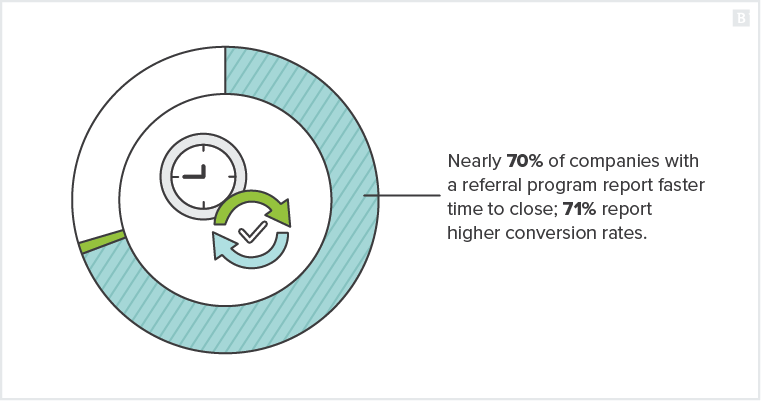
The referral model that works best for your brand will ultimately depend on your industry, but it’s something that every company should work into its sales and marketing strategy. Nearly 70% of companies with a referral program report faster time to close; 71% report higher conversion rates.
Learning from trial and error
We could probably write an entire book on this subject, but in the interest of giving you some time back, we’ll close out with an important reminder to track everything and always look for opportunities for improvement.
There is no such thing as a perfect sales and marketing strategy. But the next best thing is to use hard metrics to consistently improve.
Pay attention to the types of content that see the highest time on page, click-through and conversion rates. Look for bottlenecks in the sales cycle. Figure out where engagement is dropping off in the sales cycle. Take action to repeat your successes and eliminate your mistakes.
And then repeat that process again and again. Digital marketing is a never-ending practice. You may never achieve perfection, but you can always get better.





